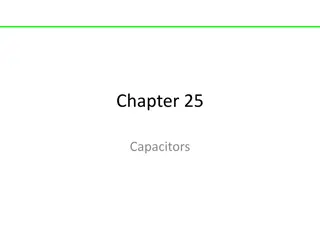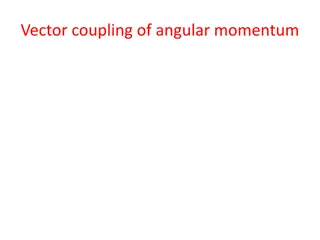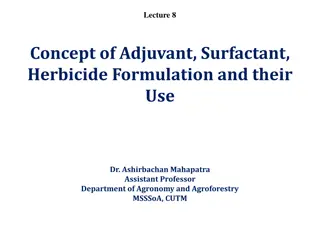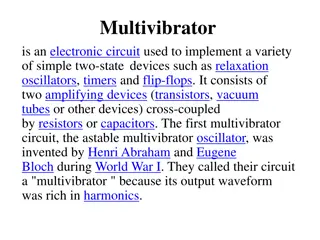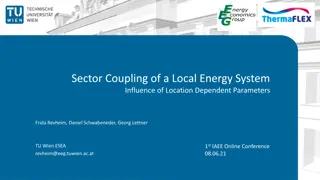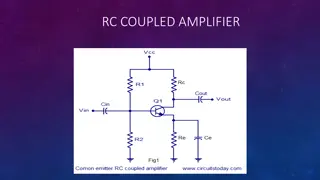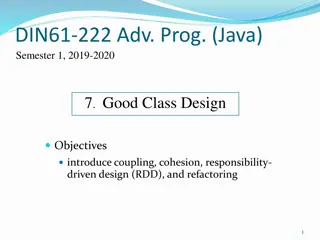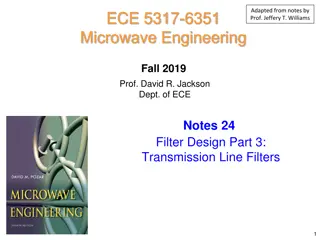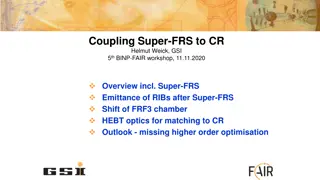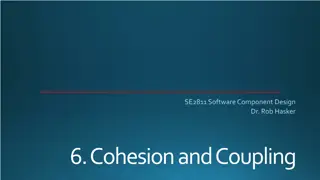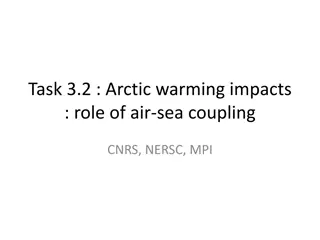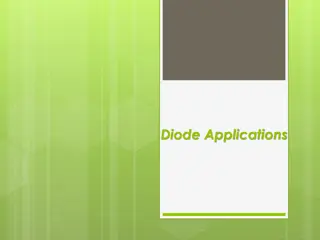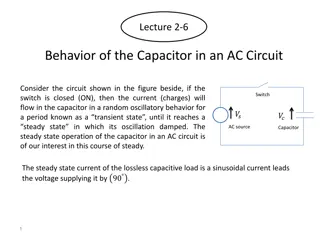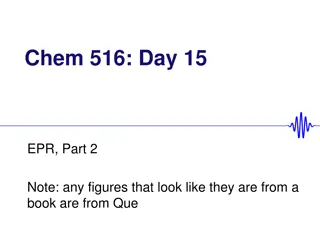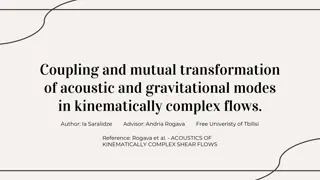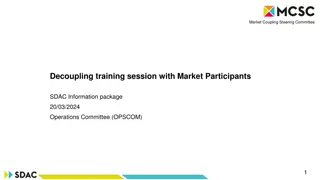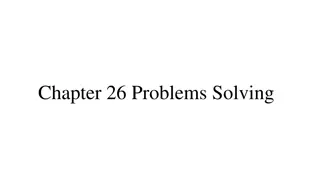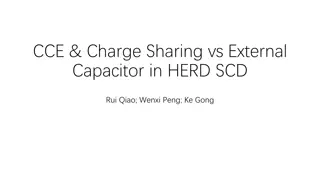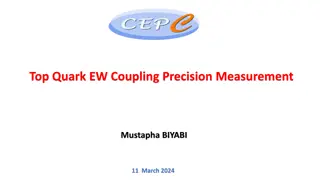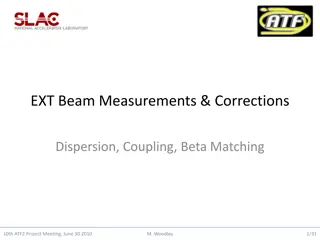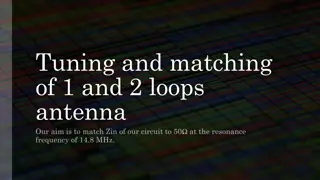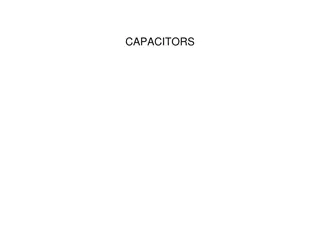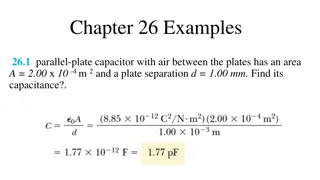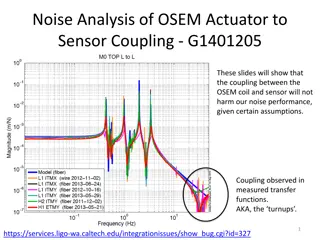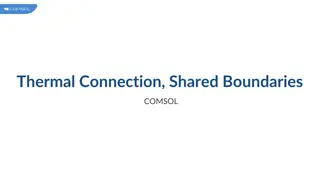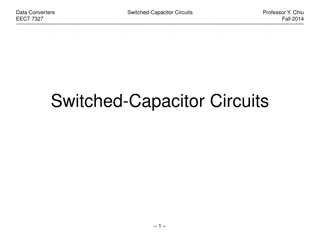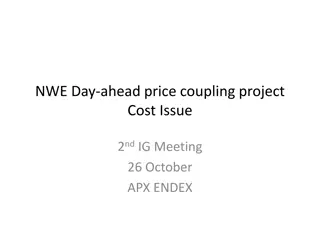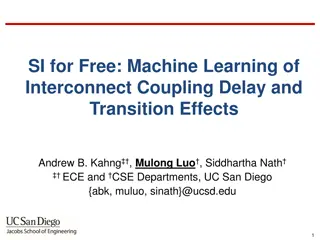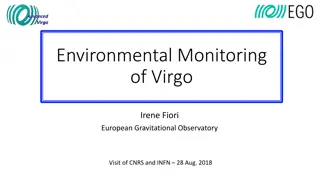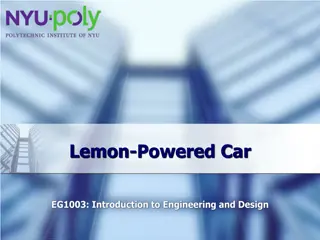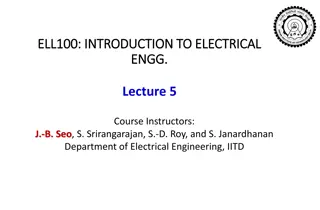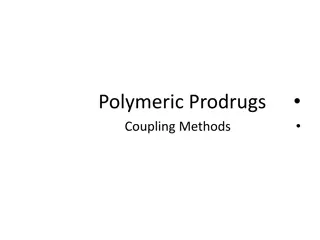FPC & HOM Technology Challenges, FCC
The challenges and technology involved in coupling beam power out of the cavity and coupling RF power into the cavity for the Future Circular Collider (FCC). It also covers the RF layout for the FCC-ee, basic parameters for proton and electron beams, accelerating RF in the LHC, input couplers, and p
0 views • 36 slides
Understanding Atomic Configurations and Term Symbols
The energy of atomic configurations is determined by electrostatic attraction between electrons and the nucleus, electron-electron repulsion, spin-orbit coupling, and spin-spin interactions. Term symbols in electronic spectroscopy specify atomic states using quantum numbers. Hund's rule and the Paul
8 views • 12 slides
High Stored Energy Emergency Discharge Systems Overview
This presentation discusses the high stored energy emergency discharge systems for klystron modulators used in RFQ/DTL and MBeta applications. It covers the storage locations of energy in various capacitor banks, the components of the system, and safety measures. The content includes detailed diagra
7 views • 10 slides
Understanding Capacitors in Physics
Capacitors are electronic components that can store electric charge and energy. This content covers various concepts related to capacitors, such as capacitance, charge storage capacity, electric fields between plates, and capacitance calculations for different geometries. Problems and examples are p
1 views • 46 slides
Amplifier Coupling Techniques and Applications
Amplifiers utilize various coupling techniques such as resistance-capacitance (RC), inductance (LC), transformer, and direct coupling to connect different stages. Each coupling method has its advantages and applications, such as impedance matching, power transfer, and amplification of radio frequenc
2 views • 16 slides
Enhancing Performance of EHV Lines through Series Compensation
Series compensation, involving connecting capacitors in series with electrical transmission lines, aims to improve EHV line performance by decreasing transmission impedance and enhancing voltage stability and transient stability. The method is a robust tool to optimize power transmission efficiency.
0 views • 51 slides
Understanding Angular Momentum in Quantum Mechanics
Exploring the concept of total angular momentum in quantum mechanics, which involves the quantization of orbital and spin angular momenta. The coupling of these vectors leads to the formation of total angular momentum, with implications for the behavior of single-electron systems like the hydrogen a
0 views • 16 slides
Understanding Waveform Generators in Electronic Circuits
Waveform generators, such as square wave oscillators and triangular wave generators, play crucial roles in electronic circuits. Square wave oscillators use capacitors and op-amps to create square wave outputs through charging and discharging processes. On the other hand, triangular wave generators u
1 views • 11 slides
Understanding Adjuvants and Herbicide Formulation
Adjuvants are additives that enhance herbicide effectiveness, crucial for optimal weed control. Types include surfactants, stabilizing agents, coupling agents, humectants, deposit builders, and more. Surfactants aid in wetting and spreading herbicides, stabilizing agents keep suspensions intact, cou
0 views • 10 slides
Overview of Multivibrators: Types and Applications
Multivibrators are electronic circuits used for various applications such as oscillators, timers, and flip-flops. They consist of two amplifying devices cross-coupled by resistors or capacitors. The three main types are astable, monostable, and bistable multivibrators, each serving different purpose
0 views • 10 slides
Analysis of Low-Frequency Response in BJT and FET Amplifiers
This analysis delves into the low-frequency response of BJT and FET amplifiers, examining the impact of various components such as resistors and capacitors on the cutoff frequencies. Detailed examples illustrate the calculation process for determining these frequencies based on specific parameters.
0 views • 18 slides
Influence of Location-Dependent Parameters on Sector Coupling in Local Energy Systems
This study explores the impact of location-dependent variables on the sector coupling of local energy systems, focusing on factors such as electricity generation, energy demands, available fuel options, and more. The research aims to evaluate the profitability and operational efficiency of such syst
3 views • 20 slides
Understanding RC Coupled Amplifiers and Transistor Basics
Amplification is the process of increasing signal strength without changing its characteristics. An RC coupled amplifier is a multistage amplifier using resistors and capacitors. Transistor amplifiers amplify signals based on transistors with different configurations. The common emitter configuratio
0 views • 23 slides
Exploring Class Design in Java Programming: Coupling, Cohesion, RDD, and Refactoring
Delve into the world of Java programming with a focus on class design principles such as coupling, cohesion, responsibility-driven design (RDD), and refactoring. Understand the importance of good design for code quality, ease of debugging, maintenance, and reusability. Dive into the adventure of Zuu
0 views • 39 slides
Microwave Filter Design Using Transmission Lines
Explore the design of microwave filters using transmission lines, starting with lumped-element designs and transitioning to transmission line approximations. Learn how to realize series inductors and shunt capacitors using narrow and wide sections of microstrip lines. Discover techniques such as Ric
0 views • 28 slides
Overview of Super-FRS Coupling to CR and Beam Envelopes
Overview of the Super-FRS coupling to CR including details on beam envelopes, acceptance after target Super-FRS, emittance of RIBs, and outlook for optimization. The content covers floor coordinates verification, beam envelopes at various points, ion reactions like fission and fragmentation on C-tar
1 views • 10 slides
Understanding Cohesion and Coupling in Software Component Design
This content discusses the concepts of cohesion and coupling in software component design. It covers the importance of having high cohesion and low coupling in software systems to ensure better structure, ease of understanding, and maintainability. It also explores how design patterns such as Adapte
0 views • 30 slides
Understanding the Impact of Arctic Warming Through Air-Sea Coupling
Investigate the role of air-sea coupling in amplifying or dampening the impact of Arctic warming on northern continents using coordinated coupled model experiments. Explore the mechanisms bridging Arctic impacts in the Northern Hemisphere via North Pacific sea surface temperature changes. Focus on t
4 views • 15 slides
Understanding Diode Applications in Modern Electronic Systems
Diodes are essential semiconductor components with various applications in electronic systems. They allow current flow in one direction, serving as one-way switches. Diodes are used in communication systems, computers, power supplies, televisions, radar circuits, and more. One significant applicatio
1 views • 19 slides
Understanding Capacitor Behavior in AC Circuits
Capacitors exhibit unique behaviors in AC circuits, transitioning from transient to steady states. By analyzing the interaction between source voltage and capacitance, we can derive key relationships such as phase differences and power transfers. Understanding these principles is essential for desig
0 views • 16 slides
Understanding Electron Paramagnetic Resonance (EPR) and Molecular Symmetry
The discussion covers the relevance and applications of EPR spectroscopy in studying electron behavior, spin-orbit coupling effects, and molecular symmetry. Key concepts include anisotropy, nuclear spin coupling, and deviations in electron g-factors. It delves into how these factors impact the obser
0 views • 11 slides
Coupling and Mutual Transformation of Acoustic and Gravitational Modes in Kinematically Complex Flows
This study explores the coupling and mutual transformation of acoustic and gravitational modes in kinematically complex flows. The research delves into phenomena such as stratified fluid, internal gravity waves, and formalism related to background flow and compressible cases. The presentation plan c
0 views • 20 slides
Market Coupling Steering Committee Decoupling Training Session
The Market Coupling Steering Committee is organizing a training session on full decoupling of the Single Day-Ahead Coupling (SDAC) system. The session will simulate scenarios, operational processes, fallback solutions, coordination, and evaluation methods. Participants will engage in a detailed oper
0 views • 10 slides
Capacitor Problems and Solutions
Explore a series of capacitor-related problems, including calculating charge, radius, capacitance, electric field, and more. Dive into scenarios involving capacitors connected to batteries, liquid drops with capacitance, Earth and cloud layers as capacitor plates, air-filled capacitors, surface char
0 views • 18 slides
Comparison of Charge Sharing Mechanisms in HERD SCD
This study delves into the analysis of charge sharing mechanisms in the HERD SCD using simulations and experimental data. It explores the impact of coupling capacitors on charge sharing efficiency and readout strip performance under various conditions to enhance signal detection and improve CCE. The
0 views • 21 slides
Insights into Top Quark EW Coupling Precision Measurement
Exciting images and information about top quark EW coupling precision measurement by Mustapha BIYABI on March 11, 2024. Explore 2D plots of top and topbar mass, boosted decision trees for analyzing signal efficiency, kinematic fitting results, lepton energy outcomes, Z boson mass measurement variati
1 views • 7 slides
Beam Measurements and Corrections at 10th ATF2 Project Meeting (June 30, 2010)
Detailed discussions on beam measurements, corrections, dispersion, coupling, and beta matching were presented at the 10th ATF2 Project Meeting. Various parameters, emittance, coupling measurement, and correction methods were examined, highlighting the importance of precise alignment and adjustments
0 views • 31 slides
Tuning and Matching of 1 and 2 Loops Antenna
The aim of the project is to match the impedance of the circuit to 50 ohms at the resonance frequency of 14.8 MHz. The process involves calculating the impedance, working at low frequencies to determine key parameters, calculating capacitors, determining Q, and finally calculating tuning and matchin
0 views • 25 slides
Understanding Capacitors in Electric Circuits
Exploring various scenarios involving capacitors in electric circuits, from analyzing the electric field between capacitor plates to determining stored energy and capacitance differences. Topics covered include equilibrium charge distribution, potential energy comparison, and stability of interconne
0 views • 7 slides
Capacitors: Examples and Applications
Explore examples of parallel-plate capacitors with varying dimensions and configurations, calculating capacitance, maximum charge, and energy storage. Understand how capacitors behave in circuits and how to determine equivalent capacitance in complex setups.
0 views • 9 slides
Noise Analysis of OSEM Actuator-Sensor Coupling
These slides detail the analysis of the coupling between the OSEM actuator and sensor, focusing on noise performance and assumptions made in the damping model. The measured open loop transfer functions and derivation of closed-loop noise transmission with OSEM coupling are discussed. Simulations and
0 views • 8 slides
Understanding Capacitors and Supercapacitors: A Comprehensive Overview
Uncover the rich history of capacitors, electrolytic capacitors, and supercapacitors, tracing back to the 18th century. Explore the differences between batteries and supercapacitors, delve into the application of supercapacitors, and learn about the fascinating development of double-layer electrolyt
0 views • 15 slides
Multiphysics Coupling for Thermal Connection in COMSOL
Establishing continuity of temperatures between volume and shell domains through surfaces in a model can reduce computational costs. Learn how to set up the Thermal Connection, Layered Shell, Surfaces multiphysics coupling node in COMSOL for heat transfer simulations. Compare results between configu
0 views • 6 slides
Switched-Capacitor Circuits in Data Converters: Fall 2014 by Professor Y. Chiu
Explore the concepts of switched-capacitor circuits in data converters through the teachings of Professor Y. Chiu during the Fall 2014 semester. Delve into topics such as continuous-time integrators, switched capacitors, discrete-time integrators, and shunt-type vs. series-type capacitors in a compr
0 views • 57 slides
NWE Day-ahead Price Coupling Project Cost Issue
Preliminary estimates of the combined PX costs for the NWE Day-ahead Price Coupling project are provided, including key assumptions, main cost elements, timing of cost commitments, and cost sharing details. The project involves the design and implementation of the PCR solution, with cost distributio
0 views • 5 slides
Machine Learning of Interconnect Coupling Delay and Transition Effects
This research paper explores the use of machine learning to study interconnect coupling delay and transition effects in VLSI design. It discusses the challenges of calibrating non-SI to SI timing reports, the impact of clock period adjustments on path slack, and the complexities involved in the cali
0 views • 32 slides
Environmental Monitoring of Virgo Irene Fiori European Gravitational Observatory Visit
The environmental monitoring of Virgo at the European Gravitational Observatory involves studying various environmental influences on the interferometer, such as electromagnetic fields, radio waves, ground motion, and mechanical vibrations. Sensors are strategically placed in experimental halls to d
0 views • 12 slides
Lemon-Powered Car Experiment: Creating Electricity from Citrus Cells
The Lemon-Powered Car experiment involves determining the potency of reducing agents, creating chemical cells to generate electricity, utilizing capacitors to store and release energy, and building a car powered by a chemical reaction. Key concepts covered include redox reactions, batteries, capacit
0 views • 21 slides
Understanding Natural Response in Electrical Engineering
In this lecture on Introduction to Electrical Engineering, the concept of natural response in circuits involving inductors and capacitors is explored. The process of energizing the components to a steady state, letting the circuit settle naturally, and analyzing the state of inductors and capacitors
0 views • 37 slides
Understanding Polymeric Prodrug Coupling Methods
Coupling methods in polymeric prodrugs involves the conjugation of drugs or biomolecules with polymers through stable bond linkages like ester, amide, or disulfide bonds. Different coupling agents and reactive groups are utilized to achieve successful conjugation, with recent advancements focusing o
0 views • 23 slides



